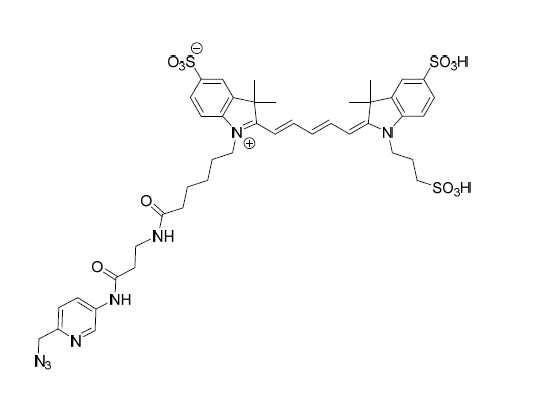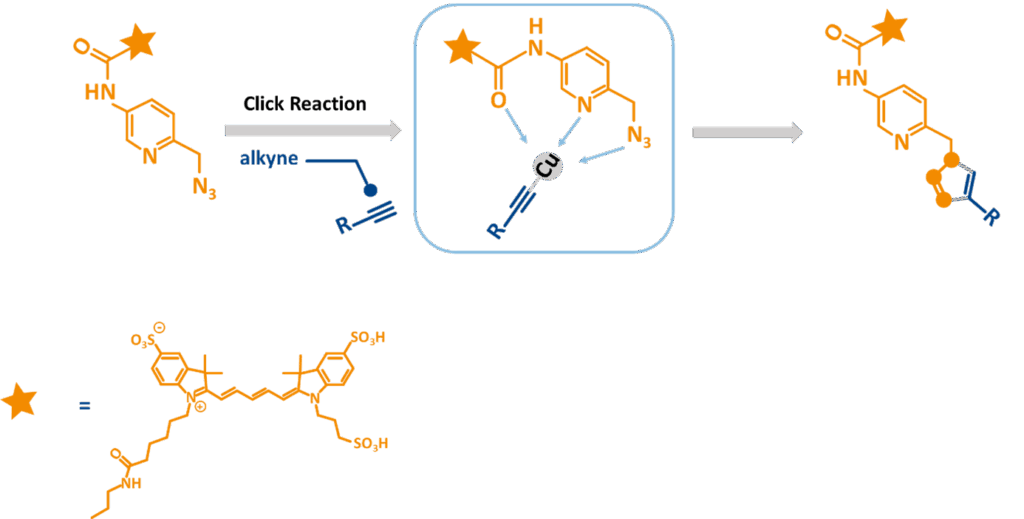Eterneon-Red 645-Picolyl-Azide
Improved 647 dye to label with reduced copper concentrations

| Size | Catalog No. | Price |
|---|---|---|
| 1 mg | BCFA-248-1 | € 250,00 |
| 5 mg | BCFA-248-5 | € 750,00 |
Chemical Properties
-
Molecular Formula
C43H52N8O11S3
-
Shelf Life
12 months unopened after receipt
-
Storage Conditions
-20 °C, dark
-
Molecular Weight
953.15 g/mol
-
Purity
≥ 95% (HPLC)
-
Physical State
blue solid
-
CAS Number
n.a.
-
Excitation (max)
647 nm
-
Emission (max)
663 nm
-
Ɛ (max)
225.000 cm-1M-1
-
Solubility
Water, DMSO, DMF, MeOH, EtOH
-
Preparation/Handling
For a 10 mM solution add 104 μL to 1 mg.
For a 10 mM solution add 520 μL to 5 mg.
Product Information
High-Efficiency Red Dye for CuAAC Labeling
Eterneon-Red 645-Picolyl-Azide is a far-red fluorescent dye (Ex/Em: 647 nm / 663 nm) engineered for copper-catalyzed azide–alkyne cycloaddition (CuAAC). Its picolyl-azide motif chelates copper ions, dramatically accelerating reaction kinetics and enabling efficient labeling at up to 10× lower copper concentrations, improving biocompatibility and reducing toxicity.

Why It’s Different
Traditional CuAAC often requires high copper levels, which can:
- Induce cell toxicity, limiting live-cell labeling.
- Damage sensitive biomolecules (proteins, enzymes, GFP, nucleic acids).
- Reduce selectivity in complex mixtures with multiple azide groups.
Eterneon-Red 645-Picolyl-Azide solves these challenges by:
- Boosting reaction efficiency: Chelating motif concentrates Cu(I), speeding up CuAAC.
- Reducing copper usage: Up to 10× less Cu(I) without sacrificing yield.
- Minimizing toxicity: Safer for live-cell imaging and delicate systems.
- Enhancing sensitivity: Strong fluorescence for low-abundance targets.
- Improving stability: Reliable labeling in biological environments.
- Maintaining bioorthogonality: No interference with native biomolecules.
- Ensuring selectivity: Targets alkyne-containing biomolecules even in complex mixtures.
Applications
- Fluorescence microscopy (live-cell and fixed samples)
- Flow cytometry
- Bioconjugation in complex biological mixtures
- Protein and nucleic acid labeling
Complementary Products:
baseclick also offers a comprehensive portfolio of red dyes for click chemistry applications, including:
LITERATURE
Efficient Tandem Copper‐Catalyzed Click Synthesis of Multisugar‐Modified Oligonucleotides. Angewandte Chemie International Edition, e202405161.
https://doi.org/10.1002/anie.202405161
FAQ
-
What makes Eterneon-Red 645-Picolyl-Azide better than standard azide dyes?
Its picolyl-azide group chelates copper ions, accelerating CuAAC reactions and allowing labeling at up to 10× lower copper concentrations, reducing toxicity and improving biocompatibility.
-
Why is lower copper concentration important?
High copper levels can damage proteins, enzymes, GFP, and nucleic acids, and cause cell toxicity. Lower copper usage preserves biomolecule integrity and enables live-cell imaging.
-
What are the excitation and emission wavelengths?
Excitation: 647 nm
Emission: 663 nm
This far-red range minimizes autofluorescence and supports deep-tissue imaging.
-
Is it compatible with common filter sets?
Yes. It shares spectral properties with Cy5, Alexa Fluor® 647, and Atto 647, so it works with standard far-red channels and red laser lines.
-
Can I use it for DNA labeling?
Yes. Its enhanced kinetics and reduced copper requirement make it suitable for DNA labeling for example; in cell imaging when combined with optimized CuAAC conditions.
-
Which biomolecules can be labeled?
Proteins, peptides, nucleic acids, and other alkyne-modified biomolecules—even in complex mixtures.
-
How does picolyl-azide improve reaction efficiency?
The picolyl group chelates Cu(I), increasing local catalyst concentration and accelerating the click reaction without excess copper.
-
Is the dye photostable and water-soluble?
Yes. It is bright, photostable, and water-soluble, ensuring reliable performance in microscopy and flow cytometry.
-
How should I store Eterneon-Red 645-Picolyl-Azide?
Store at −20 °C, protected from light. Avoid repeated freeze-thaw cycles.
-
Does baseclick offer complementary dyes?
Yes. Options include Eterneon-Red 645 Azide, AZDye 647 Azide Plus, and DBCO-AF647 for SPAAC workflows.

